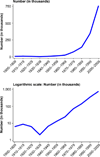Africans in the American Labor Market
- PMID: 26304845
- PMCID: PMC4607652
- DOI: 10.1007/s13524-015-0417-y
Africans in the American Labor Market
Abstract
The number of migrants to the United States from Africa has grown exponentially since the 1930s. For the first time in America's history, migrants born in Africa are growing at a faster rate than migrants from any other continent. The composition of African-origin migrants has also changed dramatically: in the mid-twentieth century, the majority were white and came from only three countries; but today, about one-fifth are white, and African-origin migrants hail from across the entire continent. Little is known about the implications of these changes for their labor market outcomes in the United States. Using the 2000-2011 waves of the American Community Survey, we present a picture of enormous heterogeneity in labor market participation, sectoral choice, and hourly earnings of male and female migrants by country of birth, race, age at arrival in the United States, and human capital. For example, controlling a rich set of human capital and demographic characteristics, some migrants-such as those from South Africa/Zimbabwe and Cape Verde, who typically enter on employment visas-earn substantial premiums relative to other African-origin migrants. These premiums are especially large among males who arrived after age 18. In contrast, other migrants-such as those from Sudan/Somalia, who arrived more recently, mostly as refugees-earn substantially less than migrants from other African countries. Understanding the mechanisms generating the heterogeneity in these outcomes-including levels of socioeconomic development, language, culture, and quality of education in countries of origin, as well as selectivity of those who migrate-figures prominently among important unresolved research questions.
Keywords: Africa; Earnings; Immigration; Migration; Work.
Figures




Similar articles
-
Economic effects of recent immigration on American workers.Migr World Mag. 1988;16(1):7-15. Migr World Mag. 1988. PMID: 12342180
-
Migration, unemployment and the urban labour market. A case study of the Sudan.Int Labour Rev. 1977 Mar-Apr;115(2):211-23. Int Labour Rev. 1977. PMID: 12265617
-
The labor market experience of female migrants: the case of temporary Mexican migration to the U.S.Int Migr Rev. 1984 Winter;18(4 Special Issue):1120-43. Int Migr Rev. 1984. PMID: 12340232
-
Research on immigrant earnings.Soc Secur Bull. 2008;68(1):31-50. Soc Secur Bull. 2008. PMID: 18837270 Review.
-
Immigration from Africa to the United States: key insights from recent research.Front Sociol. 2023 Jun 8;8:1171818. doi: 10.3389/fsoc.2023.1171818. eCollection 2023. Front Sociol. 2023. PMID: 37359213 Free PMC article. Review.
Cited by
-
Immigrants' Economic Assimilation: Evidence from Longitudinal Earnings Records.Am Sociol Rev. 2018 Aug 1;83(4):686-715. doi: 10.1177/0003122418780366. Epub 2018 Jun 15. Am Sociol Rev. 2018. PMID: 30555169 Free PMC article.
-
Predictors of Academic Success in a Nontraditional Doctor of Pharmacy Degree Program at a Historically Black College and University.Am J Pharm Educ. 2022 Dec;86(10):ajpe8600. doi: 10.5688/ajpe8600. Epub 2021 Oct 29. Am J Pharm Educ. 2022. PMID: 34716132 Free PMC article.
-
Economic Assimilation and Skill Acquisition: Evidence From the Occupational Sorting of Childhood Immigrants.Demography. 2017 Apr;54(2):571-602. doi: 10.1007/s13524-017-0558-2. Demography. 2017. PMID: 28315157
-
Life Expectancy Among U.S.-born and Foreign-born Older Adults in the United States: Estimates From Linked Social Security and Medicare Data.Demography. 2016 Aug;53(4):1109-34. doi: 10.1007/s13524-016-0488-4. Demography. 2016. PMID: 27383845 Free PMC article.
-
African Immigrants in Low-Wage Direct Health Care: Motivations, Job Satisfaction, and Occupational Mobility.J Immigr Minor Health. 2017 Jun;19(3):709-715. doi: 10.1007/s10903-016-0400-8. J Immigr Minor Health. 2017. PMID: 26995178
References
-
- Borch C, Corra MK. Differences in earnings among black and white African immigrants in the U.S., 1980–2000: A cross-sectional and temporal analysis. Sociological Perspectives. 2010;53:573–592.
-
- Borjas G. The economic analysis of immigration. In: Ashenfelter O, Card D, editors. Handbook of labor economics. 3A. Amsterdam, The Netherlands: North Holland, Elsevier Science; 1999. pp. 1697–1760.
-
- Butcher KF. Black immigrants in the U.S.: A comparison of native blacks and other immigrants. Industrial and Labor Relations Review. 1994;47:265–284.
-
- Capps R, McCabe K, Fix M. Diverse streams: Black African migration to the U.S. Washington, DC: Migration Policy Institute; 2012.
-
- Card D. The causal effect of education on earnings. In: Ashenfelter O, Card D, editors. Handbook of labor economics. 3A. Amsterdam, The Netherlands: North Holland, Elsevier Science; 1999. pp. 1801–1863.
Publication types
MeSH terms
Grants and funding
LinkOut - more resources
Full Text Sources
Other Literature Sources

